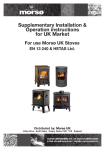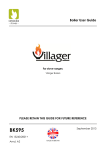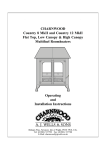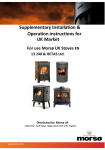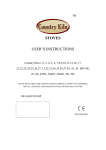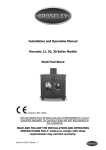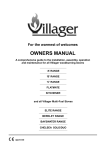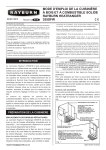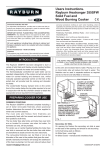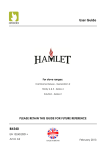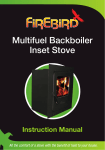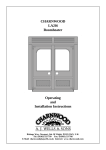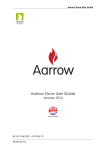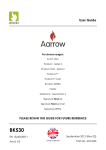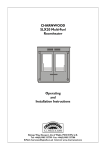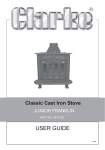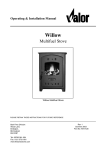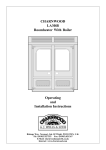Download Manor 3251 - Dartmoor Operating instructions
Transcript
STOVES USER’S INSTRUCTIONS 3200 - Winchester Stove 3205 – York Stove 3250 – Cornwall Stove 3251 – Dartmoor Stove 3252 – Cambridge Stove 3253 – Sherwood Stove 3260 – Canterbury Stove 3262 – Chartwell 3264 – Chalfont 3265 – Truro PLEASE READ THESE USER’S INSTRUCTIONS CAREFULLY WHEN YOU ASSEMBLE, INSTALL, OPERATE, AND MAINTAIN YOUR STOVE! IN CASE OF QUESTIONS, PLEASE CONTACT YOUR RETAILER. EN13240:2001 Importer: Manor Reproductions Ltd. Unit C, Hanbury Road, Stoke Prior, Bromsgrove, Worcestershire, B60 4AE The user’s instructions are suitable for Manor Stoves listed below. Please see the following chart information, and select your model: Specification Models of cast iron 3253 grey iron 18# Nominal Heat output 12 kW Recommended Weight fuels Solid mineral Dimension (H*D*W) 130kg 710*470*570(mm) fuels, peat briquettes, wood, multifuel 3205 grey iron 18# 7 kW Same above 81kg 605*320*460(mm) 3250 grey iron 18# 5kW Same above 65kg 550*310*430(mm) 3251 grey iron 18# 6kW Same above 76kg 590*360*470 (mm) 3260 grey iron 18# 8 kW Same above 93kg 610*460*465(mm) BSV09-2 grey iron 18# 6kW Same above 71kg 600*380*430 (mm) BSV09-3 grey iron 18# 4.5kW Same above 62kg 535*320*400(mm) BSV804 grey iron 18# 14kW Same above 170kg 730*470*730 (mm) BSV805 grey iron 18# 12Kw Same above 130kg 680*420*580(mm) grey iron 18# 7 kW Same above 80 kg 650*380*460(mm) 3200 3254 3252 ASSEMBLY Please assemble your stove according to the following instructions. Please exercise care at all stages due to the weight and fragility of the product and components. → Stoves come to you packaged in a plywood crate. Remove the strap bands. ↓ → Remove the crate and take out all the component parts from within the stove. ↓ → Unbolt and remove the protective plywood panel on the bottom of the stove. Take care at this stage. ↓ → fix the legs with set screws and washers supplied. Do not over-tighten bolts. ↓ → the baffle should be already fitted – if loose install to rear top chamber of stove. Fit the front retainer bar, and ash pan as shown. ↓ → fix the flue collar with set screws and washers supplied to the rear or top of the flue as required. In order for the Stove to operate efficiently it is essential for the Stove to be assembled correctly. If you have any concerns, please contact your installer or retailer. Warning When assembling the appliance, care should be taken to avoid the possibility of injury. Any unauthorized modification of the appliance is prohibited. INSTALLATION The installation of this product must comply with all local regulations, including those referring to national and European Standards. We are not responsible for any fault arising through incorrect assembly or installation. SAFETY Transport / Moving / Lifting Necessary facilities must be available for loading, unloading and site handling. Fire Cement Some types of fire cement are caustic and should not touch your skin. In case of contact, wash immediately with plenty of water. Metal Parts Be careful of personal injury when installing or maintaining this appliance. Other possible injuries The stove contains no harmful materials, but if there is a possibility of using any dangerous materials in the course of installation then please seek specialist guidance and use appropriate protective equipment where required. Important Warning! This appliance must not be installed into a chimney shared with any other heating appliance. There must not be an extractor fan fitted in the same room as the stove as this can cause the stove to emit fumes into the room. INSTALLATION Chimney The chimney must be fitted in accordance with manufacturer’s instructions and Building Regulations. The chimney height and the position of the chimney should conform to Building Regulations and all local regulations, including those referring to national and European Standards. The chimney must be in good condition, and any cracks and obstructions are not permitted. The diameter of the flue should not be less than 125mm and not more than 200mm. If any of these requirements are not met, the chimney should be lined by a suitable method. The chimney must be swept before connection to the stove. We also recommend that the chimney be swept a second time within a month of regular use after installation. Please consult your local installer / retailer, if you have any doubts about your chimney installation. Flue Draught A flue draught from 1.2mm to 2.5mm water gauge is required to keep the appliance operating efficiently. If the flue draught exceeds 2.5mm, a draught stabilizer must be installed in order to control the rate of burning and prevent overfire. You should check the flue draught when fire is on high output. Chimney Connection You should brick up or seal an existing fireplace opening with a register plate. A short length of flue pipe of a minimum 125mm internal diameter may then be used to connect the stove to the chimney. This flue pipe should be of 316 grade stainless steel or vitreous enameled, nominal thickness 1.2mm. Ensure that the pipe end is no closer than 76mm to the side or rear chimney walls. Ideally, the old fireplace should be (BACK??) filled in so that there is a smooth streamline entry into the flueway. The length of any horizontal run of flue pipe must not exceed 125mm. It is essential that all connections between the stove and chimney-flue are sealed and made airtight. Both the chimney and flue pipe must be accessible for cleaning and if any parts of the chimney cannot be reached through the stove(with baffle removed), a soot door must be fitted in a suitable position to enable this to be actioned. Air Supply A permanent, unobstructed air opening is essential for the room or space containing this appliance. The air opening should be at least 3625mm2 when a draught stabilizer is equipped. Air requirements must be carefully considered when using other appliances within the same room. Safety Clearances It is acceptable for the appliance to be recessed in a prepared fireplace, but a suitable free air gap (minimum 150mm) must be left around the sides and top and at least 50mm at the back of the appliance to reach maximum heat output and for access to the rear of the stove. All non-combustible walls closer than 300mm to the stove should be at least 75mm thick. In all circumstances the back wall of the fireplace recess and the hearth should be made of non-combustible material, Allow an apron of a least 300mm at the front of the stove and 150mm on either side. The hearth on which the stove is to be placed should not be less than 125mm thick and should be in accordance with the current building regulations. Care should be taken to level the stove. The appliance shall be installed on floors with an adequate load-bearing capacity. If an existing construction doesn’t meet this prerequisite, suitable measure (e.g. load distributing plate) should be taken to achieve it. There should be no combustible material within a distance of 500mm from any surface of the stove. Commissioning and Handover You should leave an appropriate period of time for fire cement and mortar to dry out upon completion of the installation. In order to ensure the smoke and fumes are taken from the stove up the chimney and emitted safely to atmosphere, a small fire should be lit first. Do not run the stove at full output for at least 24 hours. Finishing installation and commissioning, the operating instructions and tools for your stoves should be kept in hand. It is also important to know how to use the stove properly and use only the recommended fuels for this appliance. The user should know how to have smoke or fumes emitted properly from the stove and are warned to prevent injuries in case of the presence of children, aged or infirm persons. Operating Instructions IMPORTANT All local regulations, including those referring to national and European Standards need to be complied with when installing the appliance. This appliance is not suitable for installation in a shared flue system. The firebox and ash pan cover shall be kept closed except during ignition, refueling and removal of residue material to prevent fume spillage. It is important to use this appliance correctly so as to achieve best results. Air Controls Warning! Parts of the appliance, especially the external surfaces, will be hot to touch when in operation and due care must be taken, e.g. protective gloves should be used. It is essential for the appliance to have a sufficient air supply for combustion and ventilation. Primary Air Primary air is controlled through the assembly on the bottom of the door. This provides a conventional air draught which passes through the fuel bed. The primary air intakes can be adjusted to control the fire in combustion chamber. Secondary Air This appliance is fitted with an air wash system which can keep heat-resistant glass of door clean. This secondary air is controlled through the fittings on the top of the stove. The air controls have two types: one is rotary air controls; the other is sliding air controls. If using the sliding air controls please use the end of the ash pan tool as this slider will be hot, alternatively use stove gloves. They are operated as follows: Bottom grate Two types of bottom grate are supplied in our stoves: rotary style and grid style. For rotary style grate, you can operate it by dragging stainless steel rod forward and backward to de-ash. For grid style grate, a special hook is supplied to de-ash. It is highly recommended to de-ash regularly as any build-up of ash will damage the cast iron fuel bed. You should be careful of hot parts of the appliance in operation. Ash pan You should clean up the ash pan regularly. Please use the supplied ash pan tool to remove the ash pan out of the stove. Please exercise caution during this process. On Solid mineral fuels When placing solid mineral fuels on the fuel bed, for safety, please do not exceed an incline of more than 30o maximum from front to back. The height of loading fuels must not exceed the rear cast iron lining. The refueling intervals at nominal heat output will approximately 4 hours. We suggest you refuel in time so as to maintain the best possible results. When using solid mineral fuels, we suggest you keep the secondary air control in the closed position to maintain maximum efficiency. In this case the primary air controls can be adjusted to change the burning rate of the appliance. In order to prevent the ash from being stacked to the underside of the bottom grate, please always de-ash before refueling. Once the ash builds up, it may restrict the airflow and causes the fire to burnout. Important - It is very important to empty the ash pan regularly. If the ash builds up the underside of the grate it can burnout or distortion the grate. On Wood fuels The refueling intervals at nominal heat output will approximately 1.5 hours. You may load wood higher in the stove than when using solid mineral fuel but wood or logs are not permitted to touch the baffle plate. When using wood fuels, we suggest you keep the primary air control in the closed position, which can burn in maximum efficiency. At this time the secondary air controls can adjust the burn rate of the appliance. Wood burns best with a layer of ash on fuel bed, and care should be taken to only remove surplus residue from the stove. We recommend you only use dry, seasoned wood as fuels; the wood should have been cut, split and stacked for at least one year in circulating air surround to dry out. Otherwise, wet or unseasoned wood will cause tar deposits in the stove and unsatisfactory heat output will occur. First Fires / Burning In It is a requirement to ‘Burn In’ this appliance by having 2 or 3 small fires before operating your stove to its maximum heat output. This can help both the paint and cast iron construction to cure steadily, thereby giving a long service life to the Stove. During the initial period, there may be an unpleasant paint smell, you may keep all doors and windows open for your comfort, though the smell is non-toxic. First, load with starting fuel, i.e. paper, dry sticks or firelighters etc. Second, Light the fire at the base keeping all air controls open. Wait until the fuel reaches a steady glow, then build the fire up step by step, more fuel should be added when you have a nice fire settled across the grate bed. This should be repeated 2-3 times whilst gradually increasing the amount of fuel and building up the heat intensity gradually. Warning! You need to check for blockage prior to re-lighting after a prolonged shut down period. Shutting Down Firstly, close the primary air controls; Secondly, close the secondary air controls; The fire will eventually extinguish due to a lack of air for combustion. When lighting or reviving the fire, it is recommended to open the primary air controls first, followed by the secondary air controls. Warning! The stove will remain hot after the fire has been extinguished, please exercise caution during this time Recommended Fuels Fuels vary greatly in quality and performance. Anthracite is an approved natural smokeless fuel (not processed). Sufficient air supply and above average fuel bed temperatures are required to maintain best performance for this fuel, therefore, we suggest the fuel is used in combination with other approved manufactured smokeless fuels as per the HETAS approved list. The following fuels are approved in a closed appliance by HETAS: Coalite Cosycoke Coalite Nuts Pureheat Blazebrite Supercoke Homefire Maxibrite Homefire Ovals Newflame Phurnacite Supacite Mixed Nuts Fireglo Ovoids Ancit Dragonbrite Taybrite Anthracite Small Nuts Sunbrite Doubles Wood Logs You should only use authorized smokeless fuels in smoke control areas . Warning! The use of the appliance as an incinerator and the uses of liquid, unsuitable and non recommended fuels are prohibited. If you have any concerns in relation to the use of fuel please consult your local approved fuel merchant or any of the following bodies; HETAS Ltd.- Telephone 01242673257- www.hetas.co.uk Solid Fuel Association-Telephone 0800 600 000- www.solidfuel.co.uk SAFETY GUIDANCE FIRES CAN BE DANGEROUS - Do use a fireguard in the presence of children, the elderly or the infirm. The fireguard should be consistent for use with solid fuel appliances. DO NOT OVERFIRE- overfire can be dangerous. If any part of the stove glows red, it shows overfire is occuring. It means the Stove is operating beyond its design capacity is dangerous, you should monitor how your stove is burning and adjust the control accordingly. FUME EMISSION The emission of fumes can be avoided if the Stove is installed and operated properly; fumes usually appear from operations of de-ashing and refueling. Constant fume emission highlights a problem. If fume emission does persist, then the following measures can be helpful: 1) Open doors and windows 2) Let the fire out, or take out of fuel form the stove safely. 3) Check flue chimney to prevent blockage and clean if required. 4) Do not try to re-light the fire before the cause has been identified and corrected. 5) If needed, please seek professional assistance. Warnings! –an extractor fan is prohibited to fit in the same room as this appliance. IN THE EVENT OF CHIMNEY FIRE Let others in the house know. Call the Fire Brigade. Close all the air controls Move furniture and rugs away from the fireplace and remove any nearby ornaments. Place fireguard or spark guard in front of the stove. Feel the chimney for signs of excessive heat. If the wall is becoming hot, move the furniture away. Ensure that the Fire Brigade can have a command of your roof space in order to check the area for signs of spread. MAINTENANCE Stove body Use a soft brush to clean the stove, cleaning must be given after it has cooled down. If the stove paint finish degrades due to heat the paint can be renewed with proprietary stove paint. Baffle plate Remove and clean the baffle plate once a month to avoid soot or fly ash blocking the flue ways and producing dangerous fume emission. Fireproof glass Use a proprietary glass cleaner to clean the glass when cool. You can not use any materials which may bring glass damage to clean the panel. Wet logs on heated glass, a badly aimed poker or heavy slamming of the doors could crack the glass panels – please exercise caution. Ceramic rope The Stove uses ceramic rope on some joints. Inspect the rope around the door and glass. If rope is becoming detached, use a proprietary ceramic rope glue to reattach it. Please replace the rope if its condition is failing to seal at all points. Flueway and Chimney Keep the chimney, flueway and any connecting flue pipe swept regularly. For users of smokeless fuels, sweep at least once a year; for wood and other fuels, at least twice a year. If the stove is fitted in place of an open fire, then the chimney should be swept one month after installation to clear any soot falls which may have occurred due to the difference in combustion between the stove and the open fire. We suggest users buy replacement and spare parts only from approved retailers in your local area. Trouble Shooting No Fire can be burnt Please check the following: A proper fuel is being used. The air inlet is unobstructed. Chimneys and flueways are clear Sufficient air supply is into the room. No extractor fan is working in the same room as the stove. Fire blazing out of control Please Check: A suitable fuel is being used. The doors are tightly closed. The air controls are all in the closed position. The primary air control flap is not wedged in the open position. The glass retaining clips are not loose. The door rope seals are in good condition












